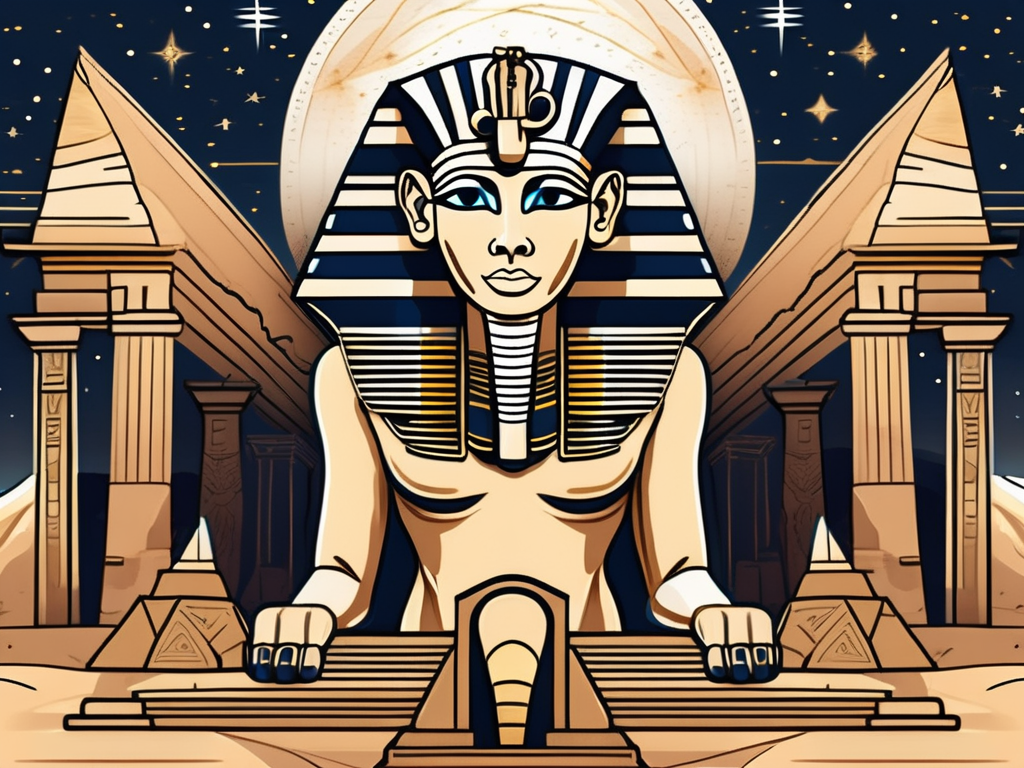Ancient Egypt is full of fascinating deities, each with their own unique stories and significance. One such god is Tayet, who holds a special place in the pantheon of Egyptian gods. In this article, we will delve into the mysteries surrounding Tayet, exploring the role this deity played in the ancient Egyptian religion and society, as well as its influence on modern interpretations of ancient Egypt.
Understanding the Role of Tayet in Ancient Egyptian Religion
A key aspect of ancient Egyptian religion was the worship of numerous gods and goddesses. Different deities were associated with specific functions and domains, and Tayet was no exception. To truly understand the significance of Tayet, we must first explore its origins.
The Origins of Tayet
Tayet is believed to have originated during the Old Kingdom of ancient Egypt, which dates back to around 2686 BCE. As the goddess of weaving and the patron deity of weavers, Tayet held a unique role in Egyptian society. The art of weaving was highly revered, as it was essential for the production of textiles used in everyday life, temples, and tombs.
Weaving in ancient Egypt was not just a practical skill but also a deeply spiritual and symbolic practice. The act of weaving was seen as a metaphor for the creation of the universe itself, with the weaver representing a divine force shaping the fabric of existence. Tayet, as the goddess of weaving, embodied this sacred connection between the physical and spiritual realms.
During the Old Kingdom, weaving was primarily a domestic craft, carried out by women in their homes. However, as the demand for textiles grew, weaving became a specialized profession, with dedicated workshops and skilled artisans. These weavers would often invoke the blessings of Tayet before beginning their work, seeking her guidance and protection in their craft.
Tayet’s Symbolism and Iconography
Depicted as a female goddess, Tayet is often portrayed wearing a long, flowing dress and holding a shuttle, symbolizing the weaving tools used in the textile industry. This iconography served as a constant reminder of Tayet’s connection to the art of weaving and its importance in Egyptian society.
The shuttle held by Tayet not only represented the physical tool used in weaving but also carried a deeper symbolic meaning. In ancient Egyptian belief, the shuttle was seen as a conduit between the mortal realm and the divine. It was believed that as the shuttle passed through the threads, it carried the blessings and protection of Tayet, infusing the fabric with her divine presence.
Furthermore, the flowing dress worn by Tayet symbolized the continuous flow of creation and the interconnectedness of all things. Just as the threads of a woven fabric are intricately intertwined, so too are the various aspects of existence woven together in a grand tapestry.
Tayet’s Role in Egyptian Mythology
Like many Egyptian deities, Tayet also played a role in mythology. In some myths, she was regarded as one of the wives of the god Ptah, the creator deity who was closely associated with craftsmanship and creation. This association further emphasized Tayet’s connection with weaving and textile production, as these crafts were seen as acts of creation.
In these myths, Tayet was often depicted as a faithful and devoted wife, supporting Ptah in his divine work. She would assist him in shaping the world and bringing order out of chaos, using her weaving skills to create the intricate patterns of existence.
It is important to note that Tayet’s role in mythology varied across different regions and time periods in ancient Egypt. In some stories, she was portrayed as a powerful goddess in her own right, while in others, she was overshadowed by other deities. This fluidity in mythological narratives reflects the complex and ever-evolving nature of ancient Egyptian religious beliefs.
The Worship and Rituals of Tayet
Now that we have explored the origins and symbolism surrounding Tayet, it is essential to delve into the worship and rituals associated with this deity.
Tayet, the ancient Egyptian goddess of weaving and textiles, held a significant place in the religious practices of the time. Her worship involved a variety of rituals and ceremonies that were performed to honor her and seek her blessings for the art of weaving.
Temples and Sacred Sites of Tayet
In ancient Egypt, temples played a crucial role in religious practices. While specific temples dedicated solely to Tayet have not been found, it is believed that she was worshipped in larger temples alongside other deities. These sacred spaces served as centers of religious activity and rituals related to Tayet’s domain.
Inside these temples, intricately carved reliefs depicted scenes of weaving and textile production, symbolizing the importance of Tayet’s role in the creation of fabrics. The walls were adorned with colorful tapestries, showcasing the mastery of the weavers and serving as offerings to the goddess.
One of the most prominent temples where Tayet was worshipped was the Temple of Isis at Philae. This temple, dedicated to the goddess Isis, also honored Tayet as one of the deities associated with weaving and craftsmanship. Pilgrims and worshippers would travel from far and wide to pay their respects to Tayet in this sacred space.
Ritual Practices Associated with Tayet
The worship of Tayet involved various ritual practices. Weavers, who held a respected position in Egyptian society, would partake in ceremonial activities to honor the goddess and seek her blessings for their work. These rituals likely included offerings of textiles and prayers for skillful weaving and successful production.
During these ceremonies, weavers would gather in the temples, dressed in their finest garments, and perform intricate dances and chants dedicated to Tayet. They would weave intricate patterns on looms, symbolizing their dedication to their craft and their devotion to the goddess.
Offerings of finely woven fabrics, dyed in vibrant colors, would be presented to Tayet as a sign of gratitude and reverence. These textiles were believed to carry the blessings of the goddess, ensuring the weavers’ success in their work.
Additionally, festivals dedicated to Tayet were held throughout the year, celebrating the art of weaving and honoring the goddess. These festivals were vibrant and lively, filled with music, dance, and competitions to showcase the skills of the weavers. It was a time of joy and celebration, as the community came together to pay homage to Tayet and the craft that she presided over.
In conclusion, the worship of Tayet was a central aspect of ancient Egyptian religious practices. The rituals and ceremonies associated with her were a testament to the importance of weaving and textiles in their society. Through these practices, the weavers sought the blessings of Tayet, ensuring their skillful craftsmanship and successful production.
Tayet’s Influence on Egyptian Culture and Society
Beyond its role in the ancient Egyptian religion, Tayet left a lasting impact on the culture and society of that time.
Tayet, the goddess of weaving, held a significant place in ancient Egyptian art and literature. Her association with weaving and textiles influenced various artistic expressions of the time. Textile motifs featuring intricate weavings were commonly incorporated into tomb murals, sculptures, and amulets, showcasing the central role of weaving in Egyptian culture. These depictions not only served as decorative elements but also symbolized the importance of craftsmanship and the skill of weaving in the society.
Ancient Egyptian literature also mentioned Tayet and highlighted her importance in the realm of craftsmanship. Poems and stories praised her role in creating beautiful textiles and emphasized the value placed on the art of weaving. By featuring Tayet in their literary works, ancient Egyptian writers further solidified her legacy and ensured that her influence would be remembered for generations to come.
Tayet’s Impact on Ancient Egyptian Art
The impact of Tayet’s association with weaving extended beyond just the realm of literature. In ancient Egyptian art, depictions of Tayet often showcased her engaged in the act of weaving, emphasizing her role as the patroness of this craft. These artistic representations not only celebrated the skill of weaving but also highlighted its social and cultural significance. Weaving was not only a practical skill but also a symbol of femininity and domesticity. The textile industry played a vital role in the economy and trade of ancient Egypt, with weavers being highly valued members of society.
Tayet’s association with weaving elevated its importance and likely had implications for social status. Skilled weavers were highly sought after and held esteemed positions in society. Their ability to create intricate and beautiful textiles was not only admired but also contributed to the wealth and prosperity of ancient Egyptian communities. The influence of Tayet in this regard cannot be overstated, as her presence in the art and culture of the time reinforced the significance of weaving and its impact on the social fabric of ancient Egyptian society.
Tayet’s Influence on Ancient Egyptian Society
Beyond the artistic realm, Tayet’s influence extended to various aspects of ancient Egyptian society. The textile industry, which she was associated with, played a crucial role in the economy and trade of the time. Weavers were responsible for producing fabrics that were used for clothing, household items, and even burial shrouds. The demand for these textiles created a thriving market, with weavers being highly valued for their skills.
Tayet’s association with weaving elevated the craft to a higher status within society. Weavers were not only admired for their technical abilities but also respected for their contributions to the community. The textiles they produced were not only practical but also served as symbols of wealth and social status. The ability to afford and wear finely woven garments was a sign of prosperity and prestige.
Furthermore, the act of weaving itself held cultural significance. It was seen as a feminine skill, associated with domesticity and the nurturing aspects of life. Women who excelled in weaving were admired for their dedication and craftsmanship. Tayet’s role as the goddess of weaving further emphasized the importance of this skill and solidified the social and cultural significance of women’s contribution to ancient Egyptian society.
Tayet’s Legacy in Modern Times
The influence of ancient Egypt can still be felt in contemporary times. Tayet, with its unique role in Egyptian mythology and society, continues to inspire modern interpretations of ancient Egypt.
Tayet in Contemporary Egyptian Culture
In modern-day Egypt, the weaving tradition that Tayet represented still holds significance. Artisans continue to practice this ancient craft, preserving the techniques and patterns that were perfected by their ancestors. The cultural heritage associated with Tayet remains alive through their work.
Tayet’s Influence on Modern Interpretations of Ancient Egypt
The enigmatic allure of ancient Egypt has captivated the world for centuries. Tayet, with its prominence in weaving and its connection to creation, has inspired contemporary artists, writers, and filmmakers. Its symbolism and iconography often find their way into modern interpretations of ancient Egyptian themes, allowing us to connect with the mysteries of the past.
In conclusion, Tayet stands as a testament to the intricate belief systems and cultural practices of ancient Egypt. From its origins as the goddess of weaving to its lasting influence on contemporary Egyptian culture and modern interpretations of ancient Egypt, Tayet offers a compelling glimpse into a civilization that continues to captivate our imagination.












